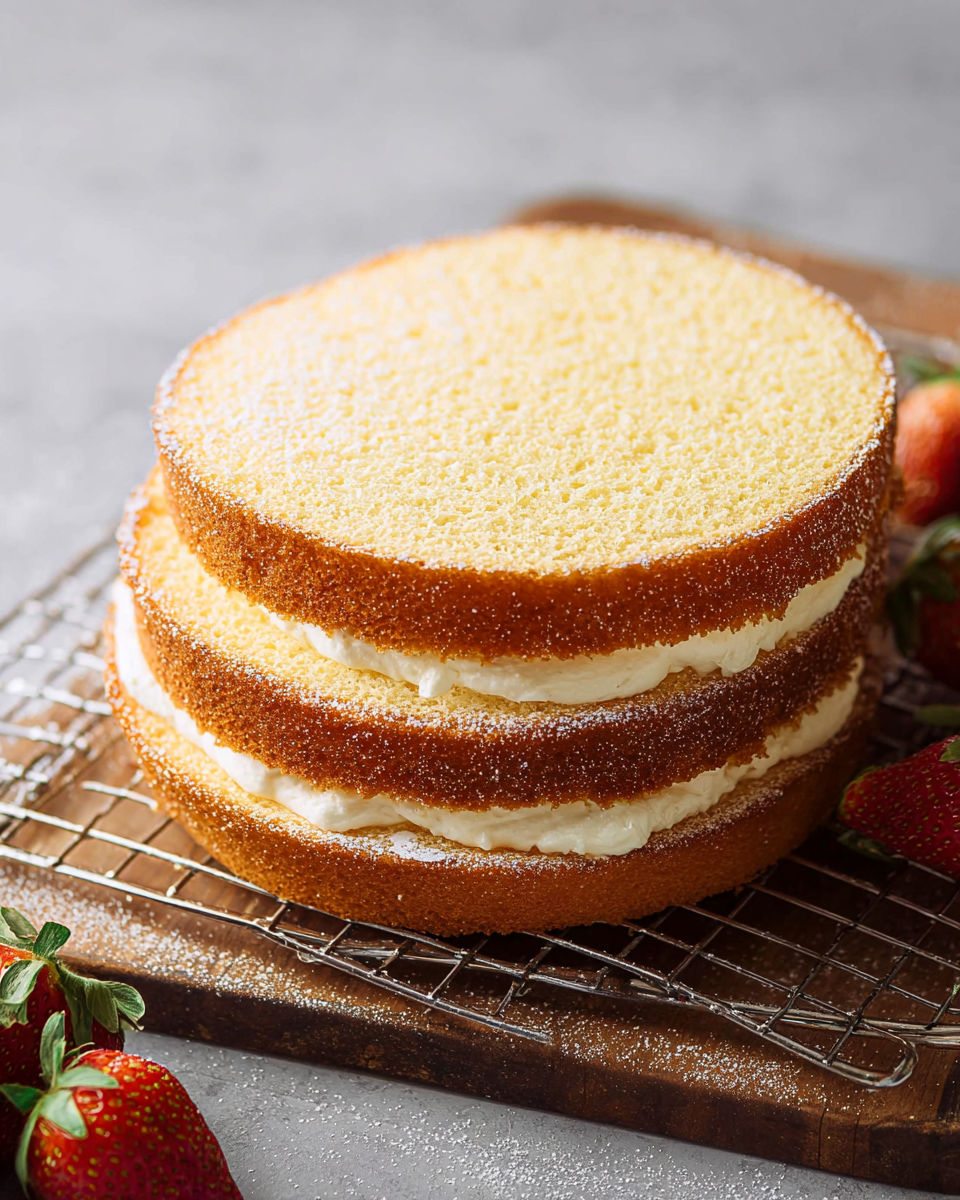The Genoise Sponge Cake is a timeless classic in the world of French patisserie. With its light, airy texture and subtle sweetness, it’s the perfect canvas for fresh fruit, whipped cream, or a luxurious pastry cream. This cake is made without leavening agents—relying solely on whipped eggs for its structure—making it both delicate and rewarding to master. Ideal for birthdays, tea parties, or celebratory gatherings, the Genoise is wonderfully versatile. It can be used as the base for layered cakes, roulades, or served simply with a dusting of powdered sugar. Whether you’re a seasoned baker or new to the kitchen, this cake is a must-try for anyone who loves refined, elegant desserts.
Full recipe:
Ingredients:
-
4 large eggs
-
½ cup (100g) granulated sugar
-
½ cup (60g) cake flour, sifted
-
2 tablespoons (15g) cornstarch
-
2 tablespoons (30g) unsalted butter, melted and cooled
-
1 teaspoon vanilla extract
-
Pinch of salt
Directions:
-
Preheat oven to 350°F (175°C). Line the bottom of an 8-inch round cake pan with parchment paper. Do not grease the sides.
-
In a large heatproof bowl, combine eggs and sugar. Set the bowl over a pot of simmering water (double boiler style) and whisk constantly until the mixture is warm and sugar is dissolved.
-
Transfer to a stand mixer and beat on high speed until tripled in volume, about 8–10 minutes. The batter should form thick ribbons.
-
Gently fold in the sifted flour, cornstarch, and salt in three additions using a spatula. Be careful not to deflate the batter.
-
Take a small amount of batter and mix it with the melted butter and vanilla. Then fold this back into the main batter.
-
Pour the batter into the prepared pan and smooth the top.
-
Bake for 25–30 minutes, or until the cake springs back when lightly pressed.
-
Let the cake cool in the pan for 10 minutes, then run a knife around the edges and invert onto a wire rack to cool completely.
-
Slice horizontally for layering or serve as-is with whipped cream and fruit.
Prep Time: 20 minutes | Cooking Time: 30 minutes | Total Time: 50 minutes
Kcal: 165 kcal | Servings: 8 servings
The Elegance of Genoise Sponge Cake
Among the many foundational cakes in the world of patisserie, few hold the same prestige as the Genoise Sponge Cake. Named after the Italian city of Genoa, this elegant cake has become a cornerstone of classic French and Italian baking. Unlike butter-heavy or leavening-packed cakes, the Genoise achieves its height and texture through expertly whipped eggs and careful folding—resulting in a cake that is simultaneously delicate, versatile, and rich in heritage.
Perfect as a base for layered celebration cakes or enjoyed with a simple dusting of sugar and seasonal fruit, the Genoise is a testament to how technique, rather than ingredients alone, can define a dessert.
What Is a Genoise Sponge Cake?
Genoise is a European sponge cake made without any chemical leaveners like baking powder or baking soda. It gets its airy structure entirely from well-beaten eggs, which are whipped with sugar over gentle heat until they become thick and voluminous. Flour is then folded in, followed by a touch of butter and vanilla for flavor.
This method of preparation results in a sponge that is less sweet and denser than an American-style sponge cake, but with a more refined crumb and firm enough texture to support layering, syrups, and creams. Unlike chiffon or angel food cake, the Genoise doesn’t crumble easily and soaks up flavor well, making it ideal for more complex constructions.
A Rich Culinary History
Though its name is Italian, the Genoise became a staple in French patisserie and was popularized in 19th-century European kitchens. Its unique method was revolutionary at the time—doing away with yeast and relying instead on air beaten into eggs.
French chefs, in particular, refined the recipe and made it the gold standard in layer cakes, entremets, and roulades. If you’ve ever enjoyed a light French birthday cake or a raspberry-soaked layered dessert in a Parisian café, chances are it was built on a Genoise base.
Its historical significance also lies in the technique itself, which has been a benchmark for culinary students for generations. Mastering the Genoise is often seen as a rite of passage in culinary schools and patisserie training programs.
Why This Genoise Sponge Cake Is the Best
What makes this particular recipe stand out is its attention to detail and technique. The gentle warming of eggs and sugar before whipping ensures full dissolution of the sugar and stabilizes the foam. Incorporating the flour and melted butter with precision helps preserve the air in the batter, which is crucial for its rise and softness.
Here are a few specific reasons this version excels:
-
Stable yet tender crumb: Perfect for layering with fillings, fruit, or mousse.
-
Absorbs syrup beautifully: Enhancing flavors without becoming soggy.
-
Rich yet not overly sweet: A refined sweetness that pairs well with tart fruits or rich creams.
-
Minimal ingredients: Uses pantry staples, yet delivers professional-quality results.
-
No leaveners needed: No baking powder or soda, relying on technique alone.
Genoise Cake vs. Other Sponge Cakes
It’s easy to confuse sponge cakes, so let’s clear up where Genoise stands in the sponge family:
-
Genoise: Uses whole eggs whipped with sugar, minimal fat (usually butter), and no chemical leaveners.
-
Chiffon Cake: Contains oil and baking powder, with whipped egg whites folded in separately.
-
Victoria Sponge: A British variant with baking powder and a higher fat content.
-
Angel Food Cake: Uses only egg whites and no fat, resulting in a very airy but drier texture.
Genoise strikes a balance—it’s more structured than angel food, lighter than Victoria, and more nuanced in flavor than chiffon. That’s why it’s the preferred base for elegant, multi-layered European desserts.
Tips for Perfecting Genoise at Home
Because this cake relies so heavily on technique, there are a few key things to keep in mind:
-
Whisking the eggs properly is everything. Use a stand mixer or hand mixer to beat the eggs and sugar until the mixture triples in volume. You should be able to draw a ribbon with the batter and have it sit on the surface briefly before sinking.
-
Don’t skip the warming step. Slightly warming the egg and sugar mixture helps the sugar dissolve and increases the volume of the foam.
-
Fold gently. The flour and melted butter should be folded in gradually and gently to avoid deflating the batter.
-
Use cake flour. The low protein content helps achieve that tender texture. If you only have all-purpose flour, try cutting it with a bit of cornstarch.
-
Don’t grease the sides of the pan. This helps the batter climb the walls of the pan for maximum rise.
Delicious Ways to Serve Genoise Cake
One of the best aspects of the Genoise is its versatility. Whether you want a show-stopping birthday cake or a delicate tea-time treat, the Genoise adapts beautifully.
-
Layered with whipped cream and berries: A classic combination that never fails.
-
Soaked with flavored syrups: Think coffee, rum, citrus, or almond extract.
-
Rolled into a Swiss roll: When baked in a sheet pan, it becomes pliable enough to roll.
-
As a base for mousse cakes: The firmness holds well under creamy layers.
-
With pastry cream and chocolate glaze: A nod to classic European patisserie.
Health Benefits and Nutritional Info
While not a “health food,” Genoise Cake has a few redeeming qualities compared to other desserts:
-
Low fat content: Uses less butter or oil than typical cakes.
-
No artificial leaveners or preservatives: Pure, straightforward ingredients.
-
Lower sugar levels: Can be adjusted depending on personal preference.
-
Good for portion control: Because of its satisfying texture, a small slice goes a long way.
At approximately 165 calories per serving, it’s a lighter option than many rich frosted cakes. Plus, you can serve it with fresh fruit for added nutrients and fiber.
Pairing Suggestions
To elevate the Genoise experience, consider pairing it with:
-
Espresso or cappuccino: Enhances the cake’s subtle sweetness.
-
Champagne or Prosecco: Perfect for celebrations.
-
Fresh berries and mint: Adds freshness and color.
-
Chocolate ganache: For a richer, more decadent twist.
Whether you’re planning a wedding cake, a birthday surprise, or just want to treat yourself to a beautifully crafted dessert, the Genoise fits every occasion.
Conclusion
The Genoise Sponge Cake isn’t just another dessert—it’s a celebration of precision, technique, and timeless European baking traditions. Its airy yet structured texture, its subtle sweetness, and its adaptability to any number of flavor pairings make it a must-have in every baker’s repertoire. Whether you’re an amateur home baker or a seasoned pastry chef, mastering the Genoise opens the door to an entire world of elegant desserts. And perhaps more importantly, it proves that sometimes, the most rewarding things in baking come from a little patience, a few simple ingredients, and a whole lot of whisking.






